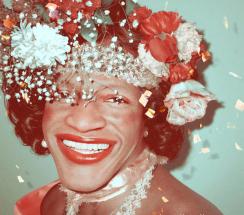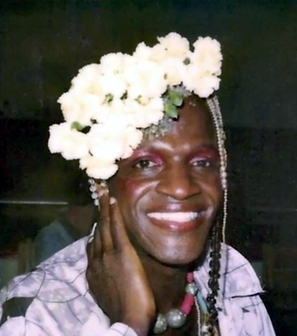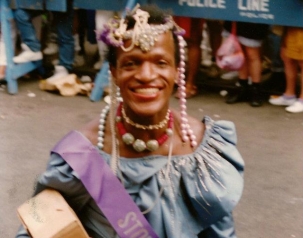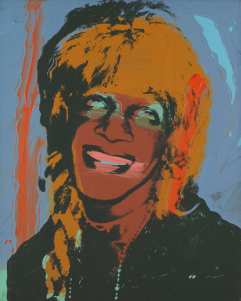 Most of the people who were at the Stonewall uprising in 1969 are primarily known for their involvement with the riot — even though most of them went on to be heavily involved in activism in the following decades. Craig Rodwell is another story. Craig was so heavily involved in activism both before and after the riots that his presence there is basically a footnote.
Most of the people who were at the Stonewall uprising in 1969 are primarily known for their involvement with the riot — even though most of them went on to be heavily involved in activism in the following decades. Craig Rodwell is another story. Craig was so heavily involved in activism both before and after the riots that his presence there is basically a footnote.
Rodwell was born October 31, 1940 in Chicago. His parents separated before his first birthday, and for the beginning of his life he was sent away to for “day care” — this day care, however, made him start doing laundry and working in the kitchen as soon as he was old enough. When he was six, his mother realized that maybe this wasn’t the best arrangement if she wanted to keep custody of him and so she sent him to a Christian Science school for “problem boys” called Chicago Junior School. He attended that school for seven years, where he got a reputation for being rebellious — but also for being a “sissy.”
By all accounts, the “problem boys” there frequently fooled around sexually — though with nothing serious behind it. At fourteen, Rodwell pursued a relationship with an adult man. When the two were caught by police, who refused to believe Rodwell when he insisted he’d started the relationship and was at fault, the man was arrested and sentenced to five years in prison for having sex with a minor. The police tried to encourage him to lie in his testimony, asking him to say that the man had paid him money. Rodwell refused, and was threatened with juvenile detention — ultimately he was just ordered by the court to see a psychiatrist, but the experience colored his view of the legal system for the rest of his life.

Rodwell also fully believed the Christian Science teachings he was learning — particularly the idea that “truth is power and that truth is the greatest good.” As a result, after he graduated and began attending Sullivan High School, he enrolled himself in a Christian science Sunday school. It was in these classes he learned that Christian Science didn’t approve of homosexuality — something Rodwell determined he was going to have to change. After high school, Rodwell relocated to Boston to study ballet before moving to New York City in 1958 — intentionally moving to Greenwich Village, where he’d heard there was a large queer community. Rodwell was hoping to become involved in the Mattachine Society.
Unfortunately, the Mattachine Society required its members to be 21 or older. Rodwell also couldn’t get into any of the gay bars yet — so he spent his time in parks, connecting with the gay community on the streets. This made him pretty vulnerable to the police, and he was involved in more than one scrape with them. But this only made him more radical.
In 1962, Rodwell was dating Harvey Milk — who was still in the closet (and just, generally, had a lot of growing to do before he becomes the Milk we all know and love). This was Rodwell’s first serious relationship. Rodwell’s outspoken activism was unsettling for Milk, and he also blamed Rodwell for an STD that he contracted. (Not unreasonable, really.) In September, Rodwell was arrested for resisting the police when they swept through a popular cruising area of Jacob Riis Park. While in jail, Rodwell was physically abused by one of the guards. When he was released from jail, Milk dumped him. His self-confidence rattled, Rodwell tried to end his own life. Fortunately for the entire queer community, the attempt failed. He left New York to travel for a couple of years.
 In 1964, Rodwell returned to New York and devoted himself to activism for the “homophile” community (as we called ourselves then — I am so glad we don’t use that term anymore). He was volunteering with the Mattachine Society — using his legal name, which was a rarity in that time — and even serving as their vice president. He founded the Mattachine Young Adults organization, and was an early member of the East Coast Homophile Organizations (ECHO) — which coordinated various homophile groups from around the eastern seaboard. On September 19, he and several other notable activists including Randy Wicker, Jefferson Poland, and Renee Cafiero staged a protest against the military’s exclusion of gay service members — and the practice of dishonorably discharging those who were found out. This is officially recognized as the first organized LGBTQ+ protest in United States history (though I suspect there were some before that we just don’t acknowledge).
In 1964, Rodwell returned to New York and devoted himself to activism for the “homophile” community (as we called ourselves then — I am so glad we don’t use that term anymore). He was volunteering with the Mattachine Society — using his legal name, which was a rarity in that time — and even serving as their vice president. He founded the Mattachine Young Adults organization, and was an early member of the East Coast Homophile Organizations (ECHO) — which coordinated various homophile groups from around the eastern seaboard. On September 19, he and several other notable activists including Randy Wicker, Jefferson Poland, and Renee Cafiero staged a protest against the military’s exclusion of gay service members — and the practice of dishonorably discharging those who were found out. This is officially recognized as the first organized LGBTQ+ protest in United States history (though I suspect there were some before that we just don’t acknowledge).
In a coordinated protest with ECHO, Rodwell and Wicker led a protest at the United Nations Plaza in New York on April 18, 1965 — joined by Allen Ginsberg, Peter Orlovsky, and roughly 25 other protesters. Days after this protest, the sit-in protest at Dewey’s began in Philadelphia. With the other leaders of ECHO, including Frank Kameny and Barbara Gittings, it was decided they needed regular protests to remind the nation about the plight of the queer community — they could not afford to only protest when there was a crisis happening in Cuba or in Philadelphia. And so, on July 4, 1965, the first of the Annual Reminders was held at Independence Hall in Philadelphia.
 In 1966, Rodwell was ejected from a bar called Julius’ for wearing a pin that read “Equality for Homosexuals.” On April 21, with the help of John Timmons and Mattachine president Dick Leitsch, Rodwell held a “sip-in” at the bar. This was specifically to protest a rule by State Liquor Authority that prohibited homosexuals from gathering in places that served alcohol. Rodwell and his cohorts held that the rule encouraged bribery and corruption amongst the police. The publicity from this sit-in led directly to that particular rule ending.
In 1966, Rodwell was ejected from a bar called Julius’ for wearing a pin that read “Equality for Homosexuals.” On April 21, with the help of John Timmons and Mattachine president Dick Leitsch, Rodwell held a “sip-in” at the bar. This was specifically to protest a rule by State Liquor Authority that prohibited homosexuals from gathering in places that served alcohol. Rodwell and his cohorts held that the rule encouraged bribery and corruption amongst the police. The publicity from this sit-in led directly to that particular rule ending.
 In order to try make the Mattachine Society more accessible, Rodwell proposed they open a storefront. When the idea was rejected, he cut his ties with the organization. In November of 1967, Rodwell opened the Oscar Wilde Memorial Bookshop — the country’s first store that focused on queer authors. The store was so named because Oscar Wilde was the most notable homosexual he could think of and he wanted absolutely not confusion about what the store was all about. The place functioned as more than just a store — Rodwell also envisioned it as a community center that didn’t have age restrictions and didn’t rely on alcohol (or the organized crime families that owned most of the gay bars in the city). To that end, he found the Homophile Youth Movement in Neighborhoods (HYMN) out of the bookshop, and led their rallies in that year. In 1968, he started publishing their periodical HYMNAL. Harvey Milk — now friends with Rodwell — was a frequent customer of the store, and it would later be the inspiration his own shop/community center/campaign headquarters Castro Camera in San Francisco. Rodwell also met Fred Sargeant at his store. Sargeant became heavily involved in HYMN and a romantic relationship blossomed.
In order to try make the Mattachine Society more accessible, Rodwell proposed they open a storefront. When the idea was rejected, he cut his ties with the organization. In November of 1967, Rodwell opened the Oscar Wilde Memorial Bookshop — the country’s first store that focused on queer authors. The store was so named because Oscar Wilde was the most notable homosexual he could think of and he wanted absolutely not confusion about what the store was all about. The place functioned as more than just a store — Rodwell also envisioned it as a community center that didn’t have age restrictions and didn’t rely on alcohol (or the organized crime families that owned most of the gay bars in the city). To that end, he found the Homophile Youth Movement in Neighborhoods (HYMN) out of the bookshop, and led their rallies in that year. In 1968, he started publishing their periodical HYMNAL. Harvey Milk — now friends with Rodwell — was a frequent customer of the store, and it would later be the inspiration his own shop/community center/campaign headquarters Castro Camera in San Francisco. Rodwell also met Fred Sargeant at his store. Sargeant became heavily involved in HYMN and a romantic relationship blossomed.
On June 28, 1969 police raided the Stonewall Inn. (Did you forget, in all of this, that this was coming up too?) Rodwell and Sargeant were walking through Greenwich Village when they happened to see a crowd gathering outside the bar — and caught the beginning of the riots. Rodwell was a leader in fighting back, and led the crowd in various “gay power” chants. He also had a camera with him, and tried to take pictures to document the event. Unfortunately, none of the pictures were successfully developed — which is extra sad because we have hardly any pictures from the first night of riots (even though Rodwell also used a pay phone to call the press and let them know what was happening). Nevertheless, he did share his account of the night — which he described as “one of those moments in history that, if you were there, you knew, this is it, this is what we’ve been waiting for.”
 The next day, Rodwell created a flyer — which HYMN helped him to disseminate through Greenwich Village — that read “Get the Mafia and the Cops Out of Gay Bars.” The flyers helped encourage further protests the next several nights — protests Rodwell participated in as well.
The next day, Rodwell created a flyer — which HYMN helped him to disseminate through Greenwich Village — that read “Get the Mafia and the Cops Out of Gay Bars.” The flyers helped encourage further protests the next several nights — protests Rodwell participated in as well.
After the annual reminder of that year — which took place a week after Stonewall — Rodwell decided that the needs of the community had been changed after the riots. He began writing a resolution in his store. In November, Rodwell, Sargeant, Ellen Broidy, and Linda Rhodes proposed the resolution at a Philadelphia meeting of ECHO to change the annual reminders. Instead of happening on July 4 in Philadelphia, they proposed, there would be simultaneous demonstrations in cities across the country on June 28. This would be called Christopher Street Liberation Day, and there would be no dress code (as the annual reminders had had) or age limitations. And so Pride began.

Despite he tremendous work so far, Rodwell found he’d never really been able to address the homophobia in Christian Science. In 1970, he placed a biography of Mary Baker Eddy in a very visible place in his store in order to meet other gay Christian Scientists. Meanwhile, he was continuing to work on advocating for queer rights. He is often credited with inventing the word “heterosexism” in January of 1971, when he wrote “After a few years of this kind of ‘liberated’ existence such people become oblivious and completely unseeing of straight predjudice and – to coin a phrase – the ‘hetero-sexism’ surrounding them virtually 24 hours a day.” In 1973, the Oscar Wilde Memorial Bookshop moved from its address on Mercer Street to the corner of Christopher Street and Gay Street.
 In 1978 Rodwell formed Gay People in Christian Science (GPICS) with Ray Spitale, Bob McCullogh, and Bob Mackenroth. While they were not the only gay Christian Science organization in the country, they were the only one actively challenging the church’s policies — actively challenging the excommunication of three of their members. This quickly became Rodwell’s primary focus for his activism. GPICS created an eight-page pamphlet entitled “Gay People in Christian Science?” which they proceeded to mail to every Christian Science church, college organization, and practitioner that they could find. Overall, they mailed out 8,000 copies. They then made plans to hand out the pamphlets at the 1980 Annual Meeting of the Church of Christ, Scientist in Boston. To organize this in the least offensive way possible, Rodwell alerted security for the event of their intentions.
In 1978 Rodwell formed Gay People in Christian Science (GPICS) with Ray Spitale, Bob McCullogh, and Bob Mackenroth. While they were not the only gay Christian Science organization in the country, they were the only one actively challenging the church’s policies — actively challenging the excommunication of three of their members. This quickly became Rodwell’s primary focus for his activism. GPICS created an eight-page pamphlet entitled “Gay People in Christian Science?” which they proceeded to mail to every Christian Science church, college organization, and practitioner that they could find. Overall, they mailed out 8,000 copies. They then made plans to hand out the pamphlets at the 1980 Annual Meeting of the Church of Christ, Scientist in Boston. To organize this in the least offensive way possible, Rodwell alerted security for the event of their intentions.
When they arrived, they discovered extremely heightened security and police presence. Undeterred, they set up their table and began distributing flyers. They were quickly informed that the booth was illegal and that they needed to leave. The group obeyed, though Rodwell and a handful of others remained on the premises and handed out their pamphlets more discreetly. Unfortunately, the pamphlet wasn’t enough to change the church’s minds and in 1981, the church fired Chris Madsen from the Christian Science Monitor for being a lesbian. GPICS returned to the annual meeting that year, this time fired up. Instead of simply handing out pamphlets, they engaged in loud and disruptive protests.
In the years that followed, queer activism within Christian Science moved to become primarily focused to areas in the Midwest. Although Rodwell remained involved, he took on a much less significant leadership role. He remained heavily involved in queer activism for the remainder of his life.
In 1992, Rodwell received the Lambda Literary Award for Publisher’s Service. In May of that year, he was diagnosed with stomach cancer. In March of 1993, he sold the Oscar Wilde Memorial Bookshop to Bill Offenbaker. He passed away on June 18 that year. It was not until 1999 that the Christian Science Church finally began to allow gay and lesbian members.
It’s honestly hard to think of anyone who, in our history, has been so devoted to our community and done so much for us. I find his name crop up in almost everything that happened for our community in New York in the late ’60s and early ’70s, and for some reason I’m always surprised. And given his influence on Harvey Milk, what he accomplished for us actually extended all the way to San Francisco.
 Although she regularly said her middle initial stood for “Pay it no mind”, Marsha P. Johnson proved to be a difficult person not to notice. Though Johnson is commonly referred to using female pronouns (she/her/hers) — and I’ll be doing that here — her actual gender identity is a bit of a mystery. She variously described herself as gay, a transvestite, and as a (drag) queen — though words like “transgender” really weren’t being widely used yet during her lifetime. My personal opinion is that she would probably identify as gender non-conforming or non-binary, but make your own judgments.
Although she regularly said her middle initial stood for “Pay it no mind”, Marsha P. Johnson proved to be a difficult person not to notice. Though Johnson is commonly referred to using female pronouns (she/her/hers) — and I’ll be doing that here — her actual gender identity is a bit of a mystery. She variously described herself as gay, a transvestite, and as a (drag) queen — though words like “transgender” really weren’t being widely used yet during her lifetime. My personal opinion is that she would probably identify as gender non-conforming or non-binary, but make your own judgments. She also began to perform as a drag queen — initially going by the name “Black Marsha” before settling on Marsha P. Johnson. She was often recognizable for having flowers in her hair — something she began doing after sleeping under flower sorting tables in Manhattan’s Flower District. She usually had on bright colored wigs, shiny dresses, and long flowing robes. Marsha was known to be peaceful and fun, but there was a violent and short-tempered side to her personality (which her friends commonly called “Malcolm”) — leading some to suspect that she suffered from schizophrenia. Between her sex work and her occasional violent outbursts, Johnson claimed to have been arrested more than a hundred times.
She also began to perform as a drag queen — initially going by the name “Black Marsha” before settling on Marsha P. Johnson. She was often recognizable for having flowers in her hair — something she began doing after sleeping under flower sorting tables in Manhattan’s Flower District. She usually had on bright colored wigs, shiny dresses, and long flowing robes. Marsha was known to be peaceful and fun, but there was a violent and short-tempered side to her personality (which her friends commonly called “Malcolm”) — leading some to suspect that she suffered from schizophrenia. Between her sex work and her occasional violent outbursts, Johnson claimed to have been arrested more than a hundred times. In 1973, Johnson also performed with the Angels of Light drag troupe — taking on the role of “The Gypsy Queen” in their production of “The Enchanted Miracle”. That same year both Johnson and Rivera were banned from participating in New York’s gay pride parade — the committee organizing the parade felt that drag queens and transvestites brought negative attention and gave the cause “a bad name.” In response, Rivera and Johnson marched ahead of the beginning of the parade.
In 1973, Johnson also performed with the Angels of Light drag troupe — taking on the role of “The Gypsy Queen” in their production of “The Enchanted Miracle”. That same year both Johnson and Rivera were banned from participating in New York’s gay pride parade — the committee organizing the parade felt that drag queens and transvestites brought negative attention and gave the cause “a bad name.” In response, Rivera and Johnson marched ahead of the beginning of the parade. In 1975, Andy Warhol took pictures of Johnson for his “Ladies and Gentlemen” series. Johnson’s success as an activist and a performer, as well as her regular appearances throughout the decade, earned her the nickname “Mayor of Christopher Street.”
In 1975, Andy Warhol took pictures of Johnson for his “Ladies and Gentlemen” series. Johnson’s success as an activist and a performer, as well as her regular appearances throughout the decade, earned her the nickname “Mayor of Christopher Street.”